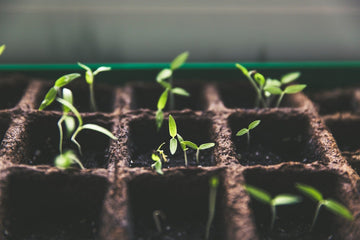15 of the best plant-based protein sources for vegans and vegetarians
by Lydia on Oct 26, 2022

We are becoming increasingly interested in following vegan or vegetarian diets in an effort to reduce our use of animal products. This can be for a number and combination of reasons, such as environmental and animal welfare factors, health or religious reasons. If we aren’t consuming animal products, it is important to plan ahead to make sure that we are reaching all our nutritional requirements, such as consuming enough protein, calcium and iron.
Here at Hero Nutrition, we are interested in intertwining our health with our functioning to enable us to perform optimally, whilst considering our environmental impact, hence our passion in encouraging a vegan or vegetarian diet. We know that protein is vital for life, as it maintains a number of bodily and cellular functions, so what are some of the best plant-based foods for protein?
Our bodies require 20 different amino acids to maintain good health, nine of which are considered essential amino acids, that we need to get from our food. Some plant products are complete proteins meaning they contain all nine essential amino acids, whilst others are missing some of these amino acids, so eating a varied diet is important.
In the UK, most adults are recommended to have 0.75g of protein per kilo of body weight per day, so the average for a woman is 45g and 56g for men (1). However, according to The International Society of Sports Nutrition most exercising individuals should be having 1.4g to 2g of protein per kilo of body weight per day (2). Every plate of food we eat should include at least one source of protein.
There are plenty of tasty, plant-based protein options…
- Tofu, tempeh and edamame are all soy products and are known for being sources of high-quality protein (3). Soybeans are uniquely rich in isoflavones, which exert oestrogen-like effects, alleviating symptoms of menopause (3). Tofu is made by curdling soya milk, pressing it into a solid block and then cooling it. Tempeh is made from cooked and slightly fermented soybeans. Tofu has a soft texture and is rather flavourless, whilst tempeh has a chewy texture and nutty flavour. Both are often used as meat replacements. Edamame beans are whole, immature soybeans, that are boiled and steamed, then add a sprinkle of salt for a delicious side dish or snack. However, soy is one of the top eight food allergens, so these products might not be an option for some.
- This is where seitan comes in as it is another good meat replacement because it is soy-free. It is made from vital wheat gluten, which is another major allergen. Recent research claims its protein quality is low though because of the low lysine content of wheat protein (4). There are many plant-based sources of lysine that you could complement seitan with, for example, avocados (a side to a seitan scramble), kidney beans (chilli), chickpeas (curry).
- Peanuts have more protein (all 20 amino acids) than any other nut and are comparable to or better than a serving of beans. They contain many other functional compounds like fibres, polyphenols, antioxidants, vitamins and minerals (5). Have them as a snack on the go, bake with peanut butter, make a peanut sauce, or sprinkle them into your salads and stir fries.
- Almonds are rich in proteins, fibre, vitamin B, vitamin E, copper, calcium and magnesium, and are a natural antioxidant and anti-inflammatory (6). Another great snack on the go.
- Spirulina is an algae grown in mineral-rich waters, with impressive protein content levels (7). Not only is spirulina a good source of protein but it is packed with antioxidant compounds that dampen oxidation and inhibit inflammation. Research has shown that spirulina prevents skeletal muscle damage that might result from exercise (8). It’s easy to add to smoothies or protein shakes.
- Quinoa’s protein quantity and quality is superior to that of other grains, such as oats and rice (9). Interestingly, quinoa protects cell membranes, with proven beneficial results in brain neuronal functions (10). Studies have found it to have a positive effect on metabolic, cardiovascular and gastrointestinal health in humans (9). Simply swap rice with quinoa.
- Chia seeds have a high concentration of protein (20%, 9 essential amino acids, 11), omega-3 fatty acids and fibre. This means they have a powerful antioxidant capacity (12). Add them to a smoothie or porridge. Make a convenient and nutritious breakfast pot or a delicious pudding.
- Hemp seeds have high levels of arginine (an essential amino acid, important for the health of the cardiovascular system) and sulfur-rich protein (13, 14). It is another natural antioxidant, and also an anti-inflammatory. It can be used in a similar way to chia seeds.
- Pulses are edible seed that grows in a pod, such as beans, peas and lentils. In comparison to other plant foods, pulses have higher proportions of protein (15). Importantly, they are affordable and there is an abundance to choose from!
- Lentils are an excellent source of plant-based protein, fibre and essential micronutrients, such as iron, zinc and vitamin B complex (16). Lentil protein is low in methionine, so partner it with a plant protein higher in methionine, like rice, hemp seeds, sesame seeds, spinach or Brazil nuts (16). They are particularly known for their high levels of polyphenols with many health benefits, such as being an antioxidant, anti-inflammatory, antibacterial and cardio protective, to name a few (17)! Lentils are a great minced beef replacement, for example, in a shepherd’s pie. Personally, I love to make a scrumptiously warm dhal.
- Chickpeas have high protein, fibre and fat content. They have high protein bioavailability and a well-balanced amino acid profile, but they too are low in methionine and also cysteine (18). Cysteine can be found in broccoli, Brussel sprouts, garlic and red peppers. Simply add chickpeas to curries or roast in the oven with other vegetables. Of course, make hummus or consume organic hummus.
- Peas are an important source of high-quality vegetable protein. They are brilliant due to their low allergenicity, high protein content, availability and affordability (19). Don’t let their size fool you, peas pack a lot of nutrients! The most prominent minerals are potassium, magnesium and calcium, and they are a source of water-soluble vitamins, particularly B vitamins (19). Again, they are low in methionine and cysteine, so consider this when meal planning!
- Beans, such as black beans, cannellini beans, kidney beans and baked beans are all sources of protein. About 64g of cooked beans provides up to 25g of protein; however, protein content differs depending of the bean and drowning environment (20). Cook a yummy burrito bowl or chilli packed with nutritious goodness.
- Vegetables, such as spinach (think Popeye!), artichokes, sweetcorn, avocado, asparagus, Brussel sprouts and mushrooms, are high ranking vegetables for protein. They also provide essential nutrients to ensure our body is functioning at its best.
- Finally, plant-based protein powder, such as our Hero Nutrition Perform + Recover formula, is a simple and healthy way to reach our daily protein intake. Personally, as somebody who is lactose intolerant and endeavouring to limit my animal-based product consumption, I find plant-based protein powder a convenient way to reach my protein intake. The protein content of brown rice, pea and soy is similar to that of whey protein (21). Combining plant-based protein powders, such as brown rice and pea, ensures that there is a high essential amino acid content (21).
Sources:
- https://www.nutrition.org.uk/healthy-sustainable-diets/protein/?level=Health%20professional#:~:text=In%20the%20UK%2C%20average%20intakes,for%20women%20depending%20on%20bodyweight)
- https://www.ncbi.nlm.nih.gov/pmc/articles/PMC5477153/
- https://www.ncbi.nlm.nih.gov/pmc/articles/PMC5188409/
- https://www.sciencedirect.com/science/article/abs/pii/S0308814620318823
- https://www.ncbi.nlm.nih.gov/pmc/articles/PMC4711439/
- https://www.ncbi.nlm.nih.gov/pmc/articles/PMC7146189/
- https://antenna.ch/wp-content/uploads/2017/03/AspectNut_UK.pdf
- https://pubmed.ncbi.nlm.nih.gov/27259333/#:~:text=Spirulina%20activates%20cellular%20antioxidant%20enzymes,taper%20off%20the%20antioxidant%20activity
- https://www.ncbi.nlm.nih.gov/pmc/articles/PMC4957693/
- https://pubmed.ncbi.nlm.nih.gov/20814881/
- https://www.ncbi.nlm.nih.gov/pmc/articles/PMC4926888/
- https://asset-pdf.scinapse.io/prod/2913105102/2913105102.pdf
- https://www.mdpi.com/2072-6643/12/7/1935/htm
- https://www.ncbi.nlm.nih.gov/pmc/articles/PMC7891210/
- https://www.ncbi.nlm.nih.gov/pmc/articles/PMC5188421/
- https://www.ncbi.nlm.nih.gov/pmc/articles/PMC6769807/
- https://www.ncbi.nlm.nih.gov/pmc/articles/PMC5713359/
- https://ift.onlinelibrary.wiley.com/doi/epdf/10.1111/1541-4337.12878
- https://www.ncbi.nlm.nih.gov/pmc/articles/PMC9412838/
- https://www.ncbi.nlm.nih.gov/pmc/articles/PMC7915747/#:~:text=A%20%C2%BD%20cup%20serving%20of,recommended%20adult%20requirement%20%5B15%5D
- https://www.ncbi.nlm.nih.gov/pmc/articles/PMC6245118/





